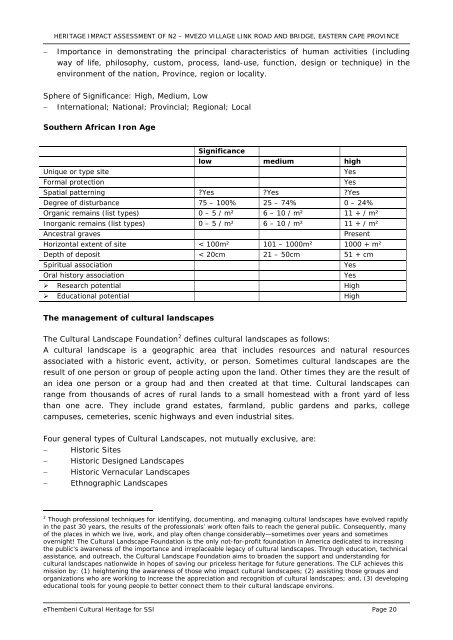HERITAGE IMPACT ASSESSMENT OF - SAHRA
HERITAGE IMPACT ASSESSMENT OF - SAHRA
HERITAGE IMPACT ASSESSMENT OF - SAHRA
Create successful ePaper yourself
Turn your PDF publications into a flip-book with our unique Google optimized e-Paper software.
<strong>HERITAGE</strong> <strong>IMPACT</strong> <strong>ASSESSMENT</strong> <strong>OF</strong> N2 – MVEZO VILLAGE LINK ROAD AND BRIDGE, EASTERN CAPE PROVINCE<br />
−<br />
Importance in demonstrating the principal characteristics of human activities (including<br />
way of life, philosophy, custom, process, land-use, function, design or technique) in the<br />
environment of the nation, Province, region or locality.<br />
Sphere of Significance: High, Medium, Low<br />
− International; National; Provincial; Regional; Local<br />
Southern African Iron Age<br />
Significance<br />
low medium high<br />
Unique or type site<br />
Yes<br />
Formal protection<br />
Yes<br />
Spatial patterning ?Yes ?Yes ?Yes<br />
Degree of disturbance 75 – 100% 25 – 74% 0 – 24%<br />
Organic remains (list types) 0 – 5 / m² 6 – 10 / m² 11 + / m²<br />
Inorganic remains (list types) 0 – 5 / m² 6 – 10 / m² 11 + / m²<br />
Ancestral graves<br />
Present<br />
Horizontal extent of site < 100m² 101 – 1000m² 1000 + m²<br />
Depth of deposit < 20cm 21 – 50cm 51 + cm<br />
Spiritual association<br />
Yes<br />
Oral history association<br />
Yes<br />
‣ Research potential High<br />
‣ Educational potential High<br />
The management of cultural landscapes<br />
The Cultural Landscape Foundation 2 defines cultural landscapes as follows:<br />
A cultural landscape is a geographic area that includes resources and natural resources<br />
associated with a historic event, activity, or person. Sometimes cultural landscapes are the<br />
result of one person or group of people acting upon the land. Other times they are the result of<br />
an idea one person or a group had and then created at that time. Cultural landscapes can<br />
range from thousands of acres of rural lands to a small homestead with a front yard of less<br />
than one acre. They include grand estates, farmland, public gardens and parks, college<br />
campuses, cemeteries, scenic highways and even industrial sites.<br />
Four general types of Cultural Landscapes, not mutually exclusive, are:<br />
− Historic Sites<br />
− Historic Designed Landscapes<br />
− Historic Vernacular Landscapes<br />
− Ethnographic Landscapes<br />
2 Though professional techniques for identifying, documenting, and managing cultural landscapes have evolved rapidly<br />
in the past 30 years, the results of the professionals’ work often fails to reach the general public. Consequently, many<br />
of the places in which we live, work, and play often change considerably—sometimes over years and sometimes<br />
overnight! The Cultural Landscape Foundation is the only not-for-profit foundation in America dedicated to increasing<br />
the public’s awareness of the importance and irreplaceable legacy of cultural landscapes. Through education, technical<br />
assistance, and outreach, the Cultural Landscape Foundation aims to broaden the support and understanding for<br />
cultural landscapes nationwide in hopes of saving our priceless heritage for future generations. The CLF achieves this<br />
mission by: (1) heightening the awareness of those who impact cultural landscapes; (2) assisting those groups and<br />
organizations who are working to increase the appreciation and recognition of cultural landscapes; and, (3) developing<br />
educational tools for young people to better connect them to their cultural landscape environs.<br />
eThembeni Cultural Heritage for SSI Page 20

















